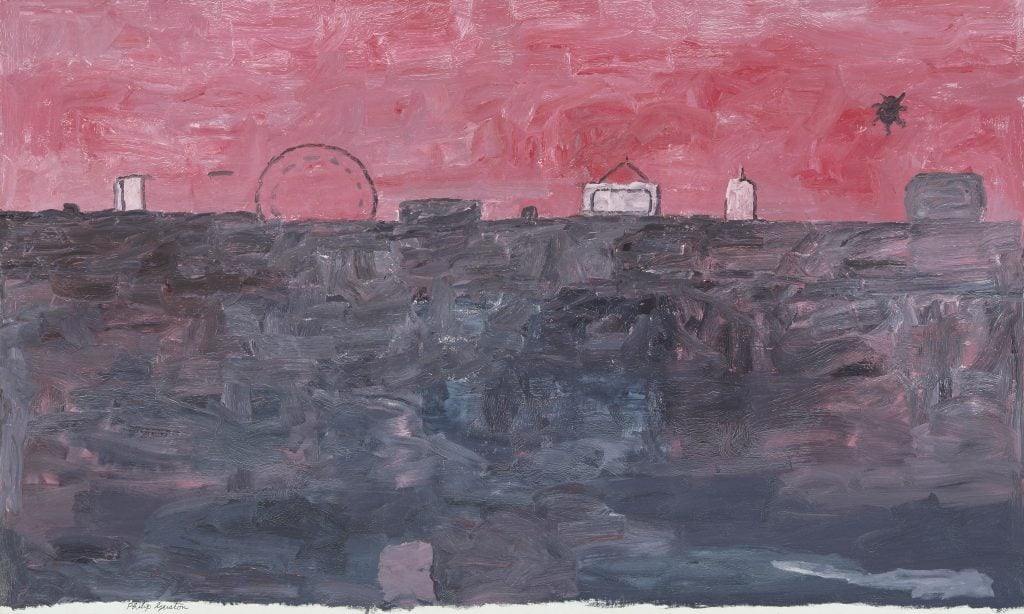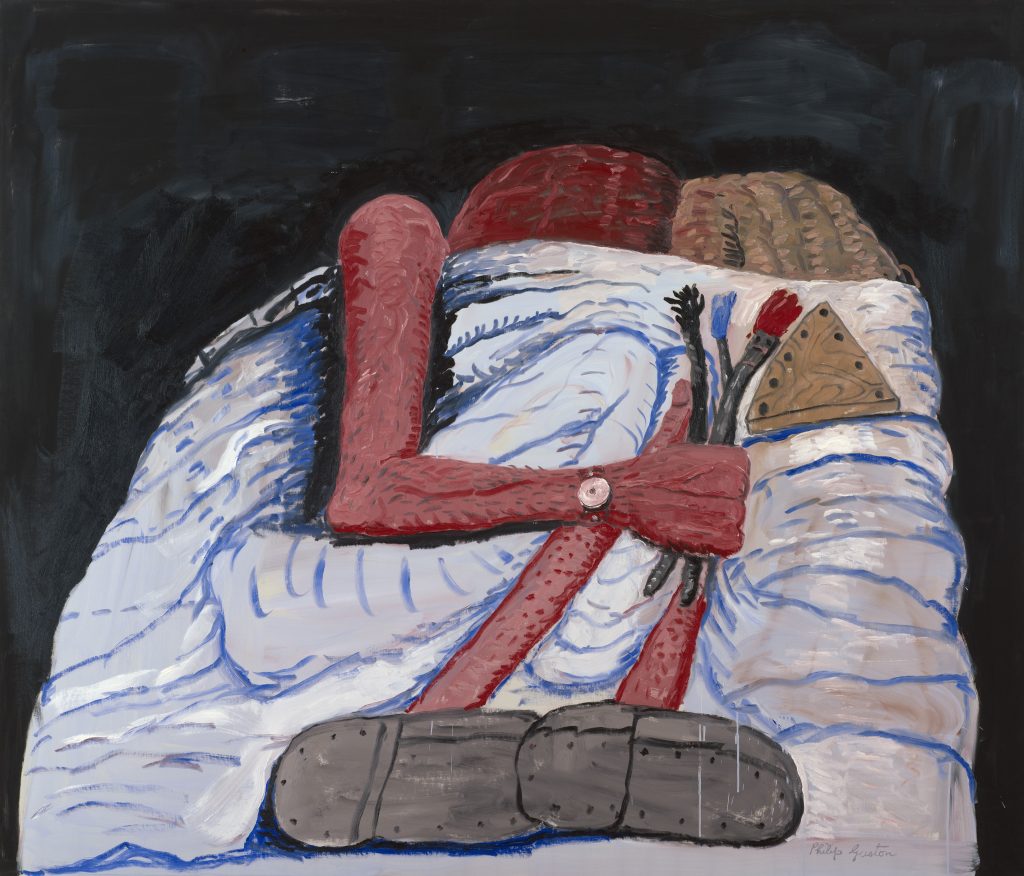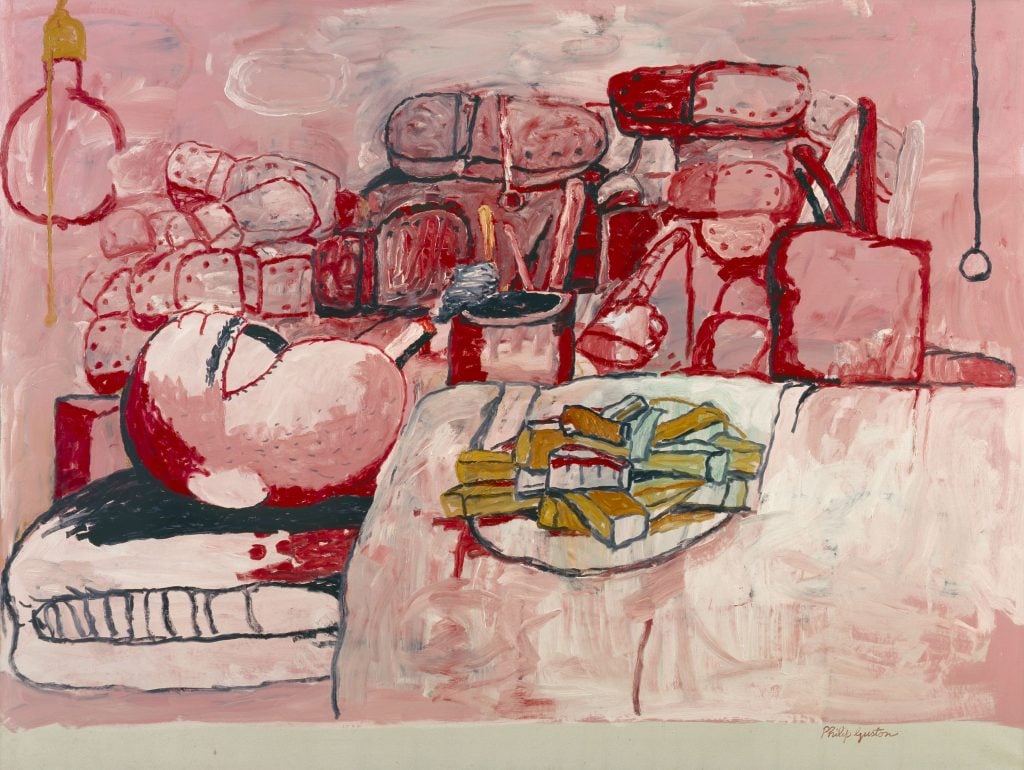On View
An Off-Ramp, a Trauma Specialist, and Preparedness Pamphlets: How the MFA Boston Reworked Its Philip Guston Retrospective
The touring show was controversially delayed for a year.

The touring show was controversially delayed for a year.

Taylor Dafoe

As curators at the Museum of Fine Arts, Boston were finalizing the checklist for their highly anticipated Philip Guston retrospective, they realized that the one painting the museum owned by the artist was not on it. Apparently, it had condition issues, so they called on a conservator to have a look at the canvas.
This was last summer, almost a full year after four museums postponed the touring exhibition over fears that Guston’s 1960s- and ‘70s-era depictions of white-hooded figures would be misunderstood in that incendiary moment of racial reckoning.
The move fomented a fiery controversy. More than 100 artists issued an open letter accusing the museums’ leaders of “white culpability.” Guston’s daughter joined the chorus of dissenters, too: “The danger,” she said at the time, “is not in looking at Philip Guston’s work, but in looking away.”
Hovering over the MFA’s own Guston work, a flooded landscape scene called The Deluge (1969), the curators saw something that, for them, refocused the debate. Underneath the painting’s oceanic foreground they spotted three subtle Ku Klux Klan hoods, which can be seen only under a certain light, in person.
“It was a very dramatic moment, as we realized that this painting has been here since 1990 and no one had noticed this,” recalled Ethan Lasser, one of four curators who organized the show. The painting promptly became the “beating heart of the show.”
“It really brought home everything we thought Guston was trying to say: that these things are hidden in plain sight,” he went on. “White supremacy is always lurking, always under the water. And here it was, right in our own institution.”

Philip Guston, The Deluge (1969). © The Estate of Philip Guston. Courtesy of Hauser and Wirth and the Museum of Fine Arts, Boston.
The Deluge is one of 73 paintings in the exhibition, which opened last weekend at the MFA. The selection is accompanied by 27 drawings and a few spare pieces of historical ephemera—a Life magazine spread documenting a Klan rally, for instance, and a series of photos of Nazi internment camps—meant to contextualize Guston’s political messaging.
The Boston presentation is smaller than the three that will follow it at the Museum of Fine Arts, Houston (October 23, 2022-January 15, 2023), the National Gallery (February 26-August 27, 2023), and the Tate Modern (October 3, 2023-February 25, 2024). It’s also, as of now, the only one to include more than one curator.
This wasn’t always the case. Lasser, the chair of the MFA’s Art of the Americas department, was asked to team up with the show’s original organizer, Guston scholar Kate Nesin, in late 2020, after the postponement announcement. He had advocated months earlier for the show to be scrapped altogether, but he agreed to help out on one condition: that Terence Washington, an independent art historian and curator, also join the effort.
Lasser had seen Washington speak in a Zoom panel in the fall of 2020 called “Talking Guston,” organized by Helen Molesworth and Laura Raicovich. During the event, Washington withheld his opinion on whether the postponement was right or wrong—”I didn’t really care either way,” he recalled—but instead addressed the tenor of the ensuing debate.

Philip Guston in his studio, 1970. Photo: Frank K. Lloyd. Courtesy of the Guston Foundation and the Museum of Fine Arts, Boston.
“I think the conversation around the postponement was framed by and large by people who disagreed with it,” he said. He noted that critics “had been speaking about audience engagement in the galleries as if it was both neutral and abstract… I think some valid questions had been left out.”
Still, one other person joined the curatorial team, and she wasn’t a curator at all: Megan Bernard, the MFA’s director of membership. The reasoning was that, as a group, the curators made a point to emphasize how the show would impact all museum-goers, not just the academic ones.
As such, they put a number of preemptive measures in place. Visitors to the exhibition are handed an “Emotional Preparedness” pamphlet, penned by a trauma specialist brought in by Bernard. The contextual materials shown alongside Guston’s art are housed in closed vitrines, which are optional for viewers to experience.
There’s also an “off-ramp” on the exhibition path prior to the gallery where the majority of the 11 artworks with Klan imagery are contained, should viewers wish to opt out at that point. (The show’s original checklist featured 15 Klan paintings. Five were removed for space considerations, and one—The Deluge—was added.)
The goal, Nesin said, was to “hold on to the open-endedness” of Guston’s work. “We’ve made some strong choices ourselves in the show, but we’ve tried really hard not to make them in ways that might foreclose the possibility that viewers can arrive at their own interpretations of paintings that are often contradictory.”
“Holding onto the ambiguity and letting it be uncomfortable, letting it push us to ask questions and sit with those questions,” Nesin added, “has really driven us.”

Philip Guston, Couple in Bed 1977. © The Estate of Philip Guston. Courtesy of Hauser and Wirth, the Art Institute of Chicago, and the Museum of Fine Arts, Boston.
The curators pointed out that Guston himself often offered contradictory statements about the intentionality of his work, many examples of which are included in the show’s wall labels and audio tour. Historians and critics also offer differing opinions. There’s even a dedicated gallery where visitors are asked to reflect on what they’ve seen and post their responses on the wall.
“How do we understand the way people might see these things?” said Washington. He recalled the revelation about the hooded figures hiding in The Deluge: “How is it that things hide in plain sight?”
Underlining the show is a larger conversation about “the way that we use artists’ intent in a curatorial framework,” Washington said. “One thing that’s important to remember is that intent does not justify impact.”

Philip Guston, Painting, Smoking, Eating (1973). © The Estate of Philip Guston. Courtesy of Hauser and Wirth and the Museum of Fine Arts, Boston.
“Philip Guston Now” is on view now through September 11, 2022 at the Museum of Fine Arts, Boston.